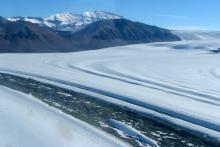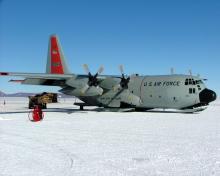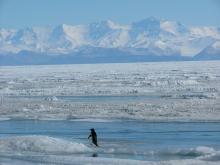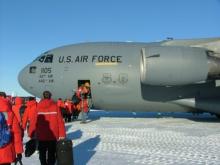Update
Check out the archived PolarConnect events with Lesley Urasky and the Glacial History in Antarctica Team from 14 December 2010 and 6 January 2011 here!
What Are They Doing?
During this project, the team worked at various sites on the Beardmore Glacier and looked for glacially transported rocks, also known as glacial erratics. Erratics are rocks carried by the glacier as the ice moves. Erratics on the Beardmore Glacier are important because they can serve as an indicator of when and how fast the Antarctic Ice Sheet receded after the last ice age 10,000-20,000 years ago.
The research team used a method called surface exposure dating to estimate the length of time that a rock has been exposed to the Earth's atmosphere. A rock on the surface of the earth is constantly bombarded by cosmic rays, energetic particles originating in outer space. When one of these particles strikes an atom in the rock, it can dislodge one or more protons or neutrons from that atom, producing a different element or a different isotope of the original element. These new elements and isotopes are called cosmogenic nuclides, and allow scientists to estimate how long the sample has been exposed to the cosmic rays.
Determining the dates and speed of past glacial recessions in Antarctica can help scientists better understand current changes in the Antarctic Ice Sheet.
Where Are They?
The team lived and worked out of several remote camps in the vicinity of the Beardmore Glacier in the Transantarctic Mountain Range of Antarctica. The Beardmore Glacier is one of the largest glaciers in the world, with a length exceeding 160 km (100 miles). Ernest Shackleton discovered the glacier in 1908, and in doing so he had discovered the first proven route to the South Pole. By climbing the Beardmore Glacier, Captain Robert Falcon Scott and his team successfully reached the South Pole.
Latest Journals

Dr. John Stone is a geologist with a particular interest in cosmic-ray-produced nuclides, or very small particles which come to earth from outer space. Working with students and collaborators, he is involved in several projects in Antarctica aimed at dating and understanding the history and changes in the glacial landscape. Other projects Dr. Stone is involved in strive to understand ancient landscapes in Australian, South America, the U.S. Pacific northwest, and Britain. To learn more about Dr. Stone's scientific interests, please visit his faculty biography page (http://depts.washington.edu/cosmolab/people.html).

Dr. Howard Conway is a research professor in the Department of Earth & Space Sciences at the University of Washington. Hi scientific interests lie in glacier and ice sheet history, as well as snow avalanches. His research focuses on observing and modeling physical processes in snow covered regions, their impacts on society, and their response to the changing environment.

Dr. Brenda Hall is an Associate Professor of Glacial and Quaternary Studies at the University of Maine Climate Change Institute. Her research interests are in understanding the stability of ice sheets and the causes of ice ages and rapid climate changes. Dr. Hall has spent several seasons in Antarctica, and at present, has research projects in the Antarctic, South America, and Greenland.





